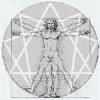“The application of the ‘table of hydrogens’ for the determination of the different properties of things and of living creatures which consist of many ‘hydrogens’ is based on the principle that in each living creature and in each thing there is one definite ‘hydrogen’ which is the center of gravity; it is, so to speak, the ‘average hydrogen’ of all the ‘hydrogens’ constituting the given creature or thing. To find this ‘average hydrogen’ we will, to begin with, speak about living creatures. First of all it is neces-sary to know the level of being of the creature in question. The level of being is primarily determined by the number of stories in the given machine. So far we have spoken only about man. And we have taken man as a three-story structure. We cannot speak about animals and man at one and the same time because animals differ in a radical way from man. The highest animals we know consist of two stories and the lowest of only one story.” “A man consists of three stories. “A sheep consists of two stories. “A WORM consists of only one story. “At the same time the lower and middle stories of a man are, so to speak, equivalent to the sheep, and the lower story — to the WORM. So that it can be said that a man consists of a man, a sheep, and a WORM, and that a sheep consists of a sheep and a WORM. Man is a complex creature; the level of his being is determined by the level of being of the creatures of which he is composed. The sheep and the WORM may play a bigger or a smaller part in man. Thus the WORM plays the chief part in man number one; in man number two — the sheep; and in man number three — man. But these definitions are important only in individual cases. In a general sense ‘man’ is determined by the center of gravity of the middle story. Fragments: Sixteen
“Let us take another example — a flour WORM. It feeds on flour, a ‘hydrogen’ far coarser than ‘hydrogen’ 768 because the WORM can also live on rotten flour. Let us say that this also is 1536. It breathes ‘hydrogen’ 192 and lives in ‘hydrogen’ 1536. Fragments: Sixteen
“If you try to continue these definitions you will see that this plan, so simple at the first glance, makes it possible to determine the most subtle distinctions between classes of living beings, especially if you bear in mind that ‘hydrogens,’ taking them as we have by octaves, are very broad concepts. For example, we took it that a dog, a fish, and a flour WORM alike feed on ‘hydrogen’ 1536, implying by this ‘hydrogen’ substances of organic origin which are not good for human food. Now, if we realize that these substances in their turn can be divided into definite classes, we shall see the possibility of very exact definitions. It is exactly the same with air and exactly the same with the medium. Fragments: Sixteen
Then much talk arose about the notes mi, re, of the lateral octave. We could not, of course, define what re was. But it was clearly connected with the idea of food for the moon. Some product of the disintegration of organic life went to the moon; this must be re. In regard to mi it was possible to speak quite definitely. Organic life undoubtedly disappeared in the earth. The role of organic life in the structure of the earth’s surface was indisputable. There was the growth of coral islands and limestone mountains, the formation of coal seams and accumulations of petroleum; the alteration of the soil under the influence of vegetation, the growth of vegetation in lakes, the “formation of rich arable lands by WORMs,” change of climate due to the draining of swamps and the destruction of forests, and many other things that we know of and do not know of. Fragments: Seven

